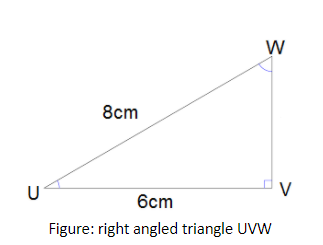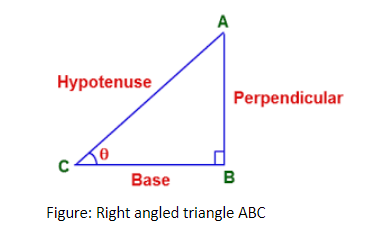
In a triangle is a right angled triangle and $\angle UVW = 90^\circ $, UV = 6 cm, and UW = 8 cm, $\sin W = p:m$, then p + m =?
Answer
581.4k+ views
Hint: Read the question carefully, consider all the given details as it leads to the solution.
Pythagoras theorem can be applied to every right angled triangle.
Pythagoras theorem: gives the relation between the sides of a right angled triangle. It is square of the hypotenuse is equal to the sum of the square of base and square of perpendicular.
In a right angled triangle, base and perpendicular are at the angle of $90^\circ $ to each other and hypotenuse is the longest side.
In every right angled triangle, relation between the side and its angle is given by trigonometric ratio.
Perpendicular is the side opposite to the angle in trigonometric ratio, hypotenuse is the longest side in a right angled triangle, remaining side is the base.
Complete step by step solution:
Step 1
Draw the figure explained in question

Step 2
Given details:
in triangle
$\angle UVW = 90^\circ $, UV = 6 cm, and UW = 8 cm,
$\sin W = p:m$
Step 3: find the remaining side of the UVW
UVW is a right angled triangle at V, thus according to
Pythagoras theorem: square of the hypotenuse is equal to the sum of the square of base and square of perpendicular.

Using Pythagoras theorem on UVW
$\mathop {{\rm{Hypotenuse}}}\nolimits^{\rm{2}} {\rm{ = }}\mathop {{\rm{ Base}}}\nolimits^{{\rm{2 }}} {\rm{ + }}\mathop {{\rm{ Perpendicular}}}\nolimits^{\rm{2}} $
$\mathop {{\rm{UV}}}\nolimits^2 + \mathop {{\rm{VW}}}\nolimits^{\rm{2}} {\rm{ }} = {\rm{ }}\mathop {{\rm{UW}}}\nolimits^{\rm{2}} $
$\begin{array}{l}
\Rightarrow \mathop 6\nolimits^2 + \mathop {{\rm{VW}}}\nolimits^{\rm{2}} {\rm{ }} = {\rm{ }}\mathop 8\nolimits^{\rm{2}} \\
\Rightarrow {\rm{ }}36 + \mathop {{\rm{VW}}}\nolimits^2 = 64\\
\Rightarrow \mathop {{\rm{VW}}}\nolimits^2 = 64 - 36 = 28
\end{array}$ (given)
…… (1)
Step 4: we know sin trigonometric relation:
$\sin W = \dfrac{{perpendicular}}{{hypotenuse}}$
${\rm{ }}\sin W = \dfrac{p}{m}$ (given)
Therefore, $\dfrac{{UV}}{{UW}} = \dfrac{p}{m}$
$\begin{array}{l}
\Rightarrow \dfrac{6}{8} = \dfrac{p}{m}\\
\Rightarrow \dfrac{3}{4} = \dfrac{p}{m}
\end{array}$
On comparing:
p = 3, m = 4
thus p + m = 3+4
= 7
The required answer is p + m = 7.
Note:
Other trigonometric ratios are:
$\cos \theta = \dfrac{{base}}{{hypotenuse}}$
In this question , \[\cos W = \dfrac{{VW}}{{UW}}\]
\[{\rm{ }} = \dfrac{{2\sqrt 7 }}{8} = \dfrac{{\sqrt 7 }}{4}\]
$\tan \theta = \dfrac{{perpendicular}}{{base}}$
In this question, $\tan W = \dfrac{{UV}}{{VW}}$
$\begin{array}{l}
= \dfrac{6}{{2\sqrt 7 }}\\
= \dfrac{{3\sqrt 7 }}{7}
\end{array}$
Pythagoras theorem can be applied to every right angled triangle.
Pythagoras theorem: gives the relation between the sides of a right angled triangle. It is square of the hypotenuse is equal to the sum of the square of base and square of perpendicular.
In a right angled triangle, base and perpendicular are at the angle of $90^\circ $ to each other and hypotenuse is the longest side.
In every right angled triangle, relation between the side and its angle is given by trigonometric ratio.
Perpendicular is the side opposite to the angle in trigonometric ratio, hypotenuse is the longest side in a right angled triangle, remaining side is the base.
Complete step by step solution:
Step 1
Draw the figure explained in question

Step 2
Given details:
in triangle
$\angle UVW = 90^\circ $, UV = 6 cm, and UW = 8 cm,
$\sin W = p:m$
Step 3: find the remaining side of the UVW
UVW is a right angled triangle at V, thus according to
Pythagoras theorem: square of the hypotenuse is equal to the sum of the square of base and square of perpendicular.

Using Pythagoras theorem on UVW
$\mathop {{\rm{Hypotenuse}}}\nolimits^{\rm{2}} {\rm{ = }}\mathop {{\rm{ Base}}}\nolimits^{{\rm{2 }}} {\rm{ + }}\mathop {{\rm{ Perpendicular}}}\nolimits^{\rm{2}} $
$\mathop {{\rm{UV}}}\nolimits^2 + \mathop {{\rm{VW}}}\nolimits^{\rm{2}} {\rm{ }} = {\rm{ }}\mathop {{\rm{UW}}}\nolimits^{\rm{2}} $
$\begin{array}{l}
\Rightarrow \mathop 6\nolimits^2 + \mathop {{\rm{VW}}}\nolimits^{\rm{2}} {\rm{ }} = {\rm{ }}\mathop 8\nolimits^{\rm{2}} \\
\Rightarrow {\rm{ }}36 + \mathop {{\rm{VW}}}\nolimits^2 = 64\\
\Rightarrow \mathop {{\rm{VW}}}\nolimits^2 = 64 - 36 = 28
\end{array}$ (given)
…… (1)
Step 4: we know sin trigonometric relation:
$\sin W = \dfrac{{perpendicular}}{{hypotenuse}}$
${\rm{ }}\sin W = \dfrac{p}{m}$ (given)
Therefore, $\dfrac{{UV}}{{UW}} = \dfrac{p}{m}$
$\begin{array}{l}
\Rightarrow \dfrac{6}{8} = \dfrac{p}{m}\\
\Rightarrow \dfrac{3}{4} = \dfrac{p}{m}
\end{array}$
On comparing:
p = 3, m = 4
thus p + m = 3+4
= 7
The required answer is p + m = 7.
Note:
Other trigonometric ratios are:
$\cos \theta = \dfrac{{base}}{{hypotenuse}}$
In this question , \[\cos W = \dfrac{{VW}}{{UW}}\]
\[{\rm{ }} = \dfrac{{2\sqrt 7 }}{8} = \dfrac{{\sqrt 7 }}{4}\]
$\tan \theta = \dfrac{{perpendicular}}{{base}}$
In this question, $\tan W = \dfrac{{UV}}{{VW}}$
$\begin{array}{l}
= \dfrac{6}{{2\sqrt 7 }}\\
= \dfrac{{3\sqrt 7 }}{7}
\end{array}$
Recently Updated Pages
Two men on either side of the cliff 90m height observe class 10 maths CBSE

What happens to glucose which enters nephron along class 10 biology CBSE

Cutting of the Chinese melon means A The business and class 10 social science CBSE

Write a dialogue with at least ten utterances between class 10 english CBSE

Show an aquatic food chain using the following organisms class 10 biology CBSE

A circle is inscribed in an equilateral triangle and class 10 maths CBSE

Trending doubts
Why is there a time difference of about 5 hours between class 10 social science CBSE

Write a letter to the principal requesting him to grant class 10 english CBSE

What is the median of the first 10 natural numbers class 10 maths CBSE

The Equation xxx + 2 is Satisfied when x is Equal to Class 10 Maths

Which of the following does not have a fundamental class 10 physics CBSE

State and prove converse of BPT Basic Proportionality class 10 maths CBSE




